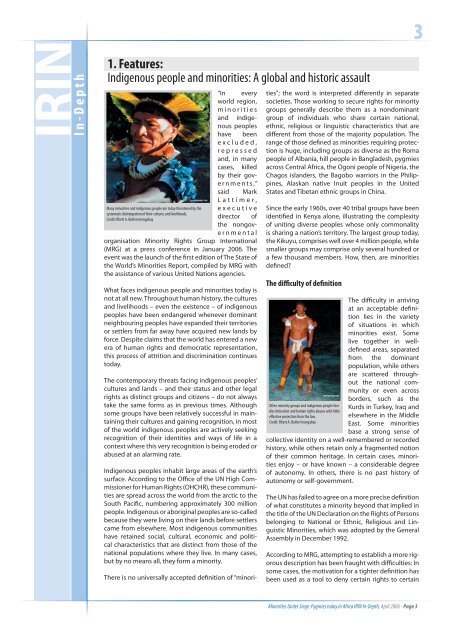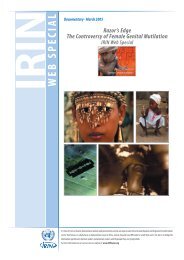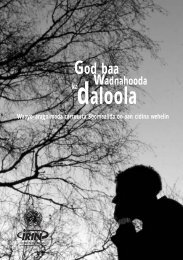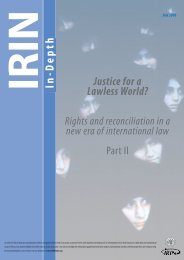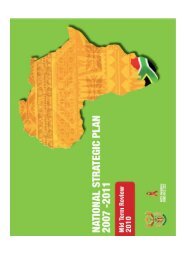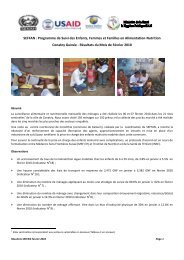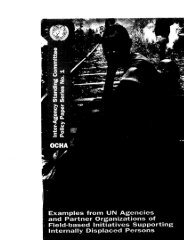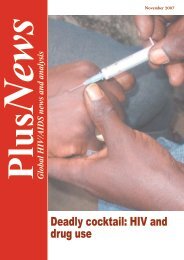Minorities Under Siege: Pygmies today in Africa - IRIN
Minorities Under Siege: Pygmies today in Africa - IRIN
Minorities Under Siege: Pygmies today in Africa - IRIN
You also want an ePaper? Increase the reach of your titles
YUMPU automatically turns print PDFs into web optimized ePapers that Google loves.
<strong>IRIN</strong><br />
I n - D e p t h<br />
1. Features:<br />
Indigenous people and m<strong>in</strong>orities: A global and historic assault<br />
“In every<br />
world region,<br />
m i n o r i t i e s<br />
and <strong>in</strong>digenous<br />
peoples<br />
have been<br />
e x c l u d e d ,<br />
r e p r e s s e d<br />
and, <strong>in</strong> many<br />
cases, killed<br />
by their gove<br />
r n m e n t s ,”<br />
said Mark<br />
L a t t i m e r ,<br />
Many m<strong>in</strong>orities and <strong>in</strong>digenous people are <strong>today</strong> threatened by the e x e c u t i v e<br />
systematic dis<strong>in</strong>tegration of their cultures and livelihoods.<br />
director of<br />
Credit: Rhett A. Butler/mongabay<br />
the nongove<br />
r n m e n t a l<br />
organisation M<strong>in</strong>ority Rights Group International<br />
(MRG) at a press conference <strong>in</strong> January 2006. The<br />
event was the launch of the first edition of The State of<br />
the World’s <strong>M<strong>in</strong>orities</strong> Report, compiled by MRG with<br />
the assistance of various United Nations agencies.<br />
What faces <strong>in</strong>digenous people and m<strong>in</strong>orities <strong>today</strong> is<br />
not at all new. Throughout human history, the cultures<br />
and livelihoods – even the existence – of <strong>in</strong>digenous<br />
peoples have been endangered whenever dom<strong>in</strong>ant<br />
neighbour<strong>in</strong>g peoples have expanded their territories<br />
or settlers from far away have acquired new lands by<br />
force. Despite claims that the world has entered a new<br />
era of human rights and democratic representation,<br />
this process of attrition and discrim<strong>in</strong>ation cont<strong>in</strong>ues<br />
<strong>today</strong>.<br />
The contemporary threats fac<strong>in</strong>g <strong>in</strong>digenous peoples’<br />
cultures and lands – and their status and other legal<br />
rights as dist<strong>in</strong>ct groups and citizens – do not always<br />
take the same forms as <strong>in</strong> previous times. Although<br />
some groups have been relatively successful <strong>in</strong> ma<strong>in</strong>ta<strong>in</strong><strong>in</strong>g<br />
their cultures and ga<strong>in</strong><strong>in</strong>g recognition, <strong>in</strong> most<br />
of the world <strong>in</strong>digenous peoples are actively seek<strong>in</strong>g<br />
recognition of their identities and ways of life <strong>in</strong> a<br />
context where this very recognition is be<strong>in</strong>g eroded or<br />
abused at an alarm<strong>in</strong>g rate.<br />
Indigenous peoples <strong>in</strong>habit large areas of the earth’s<br />
surface. Accord<strong>in</strong>g to the Office of the UN High Commissioner<br />
for Human Rights (OHCHR), these communities<br />
are spread across the world from the arctic to the<br />
South Pacific, number<strong>in</strong>g approximately 300 million<br />
people. Indigenous or aborig<strong>in</strong>al peoples are so-called<br />
because they were liv<strong>in</strong>g on their lands before settlers<br />
came from elsewhere. Most <strong>in</strong>digenous communities<br />
have reta<strong>in</strong>ed social, cultural, economic and political<br />
characteristics that are dist<strong>in</strong>ct from those of the<br />
national populations where they live. In many cases,<br />
but by no means all, they form a m<strong>in</strong>ority.<br />
There is no universally accepted def<strong>in</strong>ition of “m<strong>in</strong>orities”;<br />
the word is <strong>in</strong>terpreted differently <strong>in</strong> separate<br />
societies. Those work<strong>in</strong>g to secure rights for m<strong>in</strong>ority<br />
groups generally describe them as a nondom<strong>in</strong>ant<br />
group of <strong>in</strong>dividuals who share certa<strong>in</strong> national,<br />
ethnic, religious or l<strong>in</strong>guistic characteristics that are<br />
different from those of the majority population. The<br />
range of those def<strong>in</strong>ed as m<strong>in</strong>orities requir<strong>in</strong>g protection<br />
is huge, <strong>in</strong>clud<strong>in</strong>g groups as diverse as the Roma<br />
people of Albania, hill people <strong>in</strong> Bangladesh, pygmies<br />
across Central <strong>Africa</strong>, the Ogoni people of Nigeria, the<br />
Chagos islanders, the Bagobo warriors <strong>in</strong> the Philipp<strong>in</strong>es,<br />
Alaskan native Inuit peoples <strong>in</strong> the United<br />
States and Tibetan ethnic groups <strong>in</strong> Ch<strong>in</strong>a.<br />
S<strong>in</strong>ce the early 1960s, over 40 tribal groups have been<br />
identified <strong>in</strong> Kenya alone, illustrat<strong>in</strong>g the complexity<br />
of unit<strong>in</strong>g diverse peoples whose only commonality<br />
is shar<strong>in</strong>g a nation’s territory. The largest group <strong>today</strong>,<br />
the Kikuyu, comprises well over 4 million people, while<br />
smaller groups may comprise only several hundred or<br />
a few thousand members. How, then, are m<strong>in</strong>orities<br />
def<strong>in</strong>ed?<br />
The difficulty of def<strong>in</strong>ition<br />
Often m<strong>in</strong>ority groups and <strong>in</strong>digenous people face<br />
discrim<strong>in</strong>ation and human rights abuses with little<br />
effective protection from the law.<br />
Credit: Rhett A. Butler/mongabay<br />
3<br />
The difficulty <strong>in</strong> arriv<strong>in</strong>g<br />
at an acceptable def<strong>in</strong>ition<br />
lies <strong>in</strong> the variety<br />
of situations <strong>in</strong> which<br />
m<strong>in</strong>orities exist. Some<br />
live together <strong>in</strong> welldef<strong>in</strong>ed<br />
areas, separated<br />
from the dom<strong>in</strong>ant<br />
population, while others<br />
are scattered throughout<br />
the national community<br />
or even across<br />
borders, such as the<br />
Kurds <strong>in</strong> Turkey, Iraq and<br />
elsewhere <strong>in</strong> the Middle<br />
East. Some m<strong>in</strong>orities<br />
base a strong sense of<br />
collective identity on a well-remembered or recorded<br />
history, while others reta<strong>in</strong> only a fragmented notion<br />
of their common heritage. In certa<strong>in</strong> cases, m<strong>in</strong>orities<br />
enjoy – or have known – a considerable degree<br />
of autonomy. In others, there is no past history of<br />
autonomy or self-government.<br />
The UN has failed to agree on a more precise def<strong>in</strong>ition<br />
of what constitutes a m<strong>in</strong>ority beyond that implied <strong>in</strong><br />
the title of the UN Declaration on the Rights of Persons<br />
belong<strong>in</strong>g to National or Ethnic, Religious and L<strong>in</strong>guistic<br />
<strong>M<strong>in</strong>orities</strong>, which was adopted by the General<br />
Assembly <strong>in</strong> December 1992.<br />
Accord<strong>in</strong>g to MRG, attempt<strong>in</strong>g to establish a more rigorous<br />
description has been fraught with difficulties: In<br />
some cases, the motivation for a tighter def<strong>in</strong>ition has<br />
been used as a tool to deny certa<strong>in</strong> rights to certa<strong>in</strong><br />
<strong>M<strong>in</strong>orities</strong> <strong>Under</strong> <strong>Siege</strong>: <strong>Pygmies</strong> <strong>today</strong> <strong>in</strong> <strong>Africa</strong> <strong>IRIN</strong> In-Depth, April 2006 - Page 3


